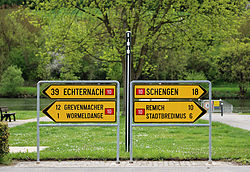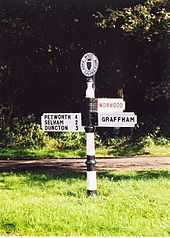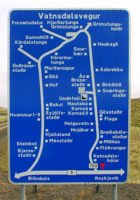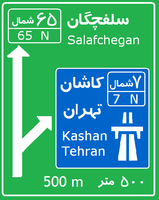Direction, position, or indication sign



A direction sign, more fully defined as a direction, position, or indication sign by the
Direction signs are the oldest type of road sign;
History
Pre-automobile

The first direction signs were
The use of milestones continued following the decline of the Roman Empire. However, as trading between towns and regions increased, milestones were found to be inconvenient for giving directions at

Modernisation

Most early direction signs were based on the traditional styles in use in area; the United Kingdom used adapted, cast iron fingerposts for signing directions,[3] while the United States adopted an ad hoc scheme based on traditional trail markings. These proved unwieldy, and modernisation efforts quickly sprang up to change them. However, the changes faced opposition, both from traditionalists who preferred the style or charm of older signs, and from businesses along affected routes, which feared that standardised direction signs would favour the new highways, causing rural routes to fade into obscurity.[4]
The advent of
Design
The Vienna Convention on Road Signs and Signals divides the direction, position, or indication sign category into direction signs, which are only those giving distances or directions to a given location; road identification signs (also known as "reassurance signs"), which repeat the name or number of the road, and place identification signs, which give the name of a landmark, such as a town, river or border. Unlike the other classes of sign, direction signs remain broadly undefined by the convention; the only restrictions given are that direction signs must be either a rectangle or an arrow shaped pentagon, and that they may not contain placenames in more than two languages. Additionally, direction signs on motorways must be blue or green, while temporary direction signs are yellow or orange.[1]
As a result, different nations can have wildly different direction signs; the United States uses verbose green gantry signs almost universally in built up areas, with few diagrams beyond basic arrows, Road signs in Israel and the Palestinian territories are of similar design to North American signage, but vary in color depending on whether the sign indicates direction for through traffic, exiting traffic, etc.
Direction signs can also be used in conjunction with other types of sign: for example, in the United Kingdom, if a warning or prohibitory sign appears on a direction sign, it means that the route indicated by the sign contains the hazard or prohibition sign posted.[8]
-
An Icelandic road sign, with detailed directions to nearby farmsteads.
-
The Junction of Freeway 7 (Iran) and Road 65 (Iran)
-
A simple German sign on the approach to anoff ramp.
-
Signage along Interstate 35 in Emporia, Kansas, USA.
-
Direction signs for a minor route to a destination (white) and tourist attraction (brown) in Switzerland
Evacuation routes

Some areas have special
Evacuation signs are common in areas where there is a high risk of dangers such as flash
See also
References
- ^ a b Vienna Convention on Road Signs and Signals (PDF). United Nations Economic and Social Council. 6 June 1978. pp. 44–46. Retrieved 2007-09-14.
- ^ a b Smith, William (1875). "Milliare". A Dictionary of Greek and Roman Antiquities. John Murray.
- ^ a b c "Traditional Direction Signs". Department for Transport. Archived from the original (PDF) on 2007-06-14. Retrieved 2007-10-31.
- ISBN 0-7864-0822-7.
- ISBN 0-8135-2691-4.
- ^ "From War to Worboys". CBRD. Archived from the original on 2007-10-27. Retrieved 2007-10-31.
- ^ a b Manual on Uniform Traffic Control Devices 2003 edition
- ^ Highway Code
- ISSN 0037-4237.
External links
 Media related to Directional road signs at Wikimedia Commons
Media related to Directional road signs at Wikimedia Commons






